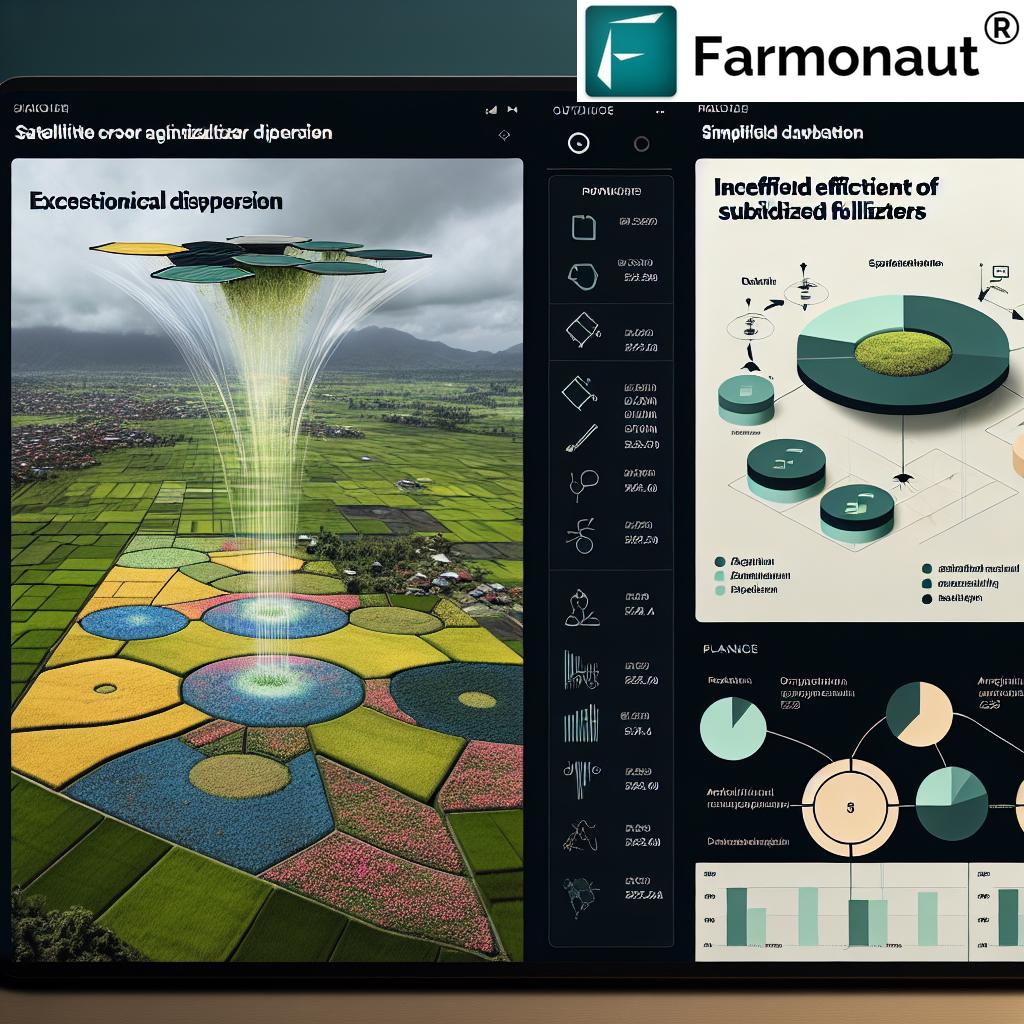Beetle Pest Fiji Sugarcane Maize: 5 Powerful 2025 Solutions
Table of Contents
- Introduction: Fiji’s Agricultural Backbone and the Beetle Pest Menace
- Trivia: Beetle Pests’ Economic Burden
- Ecology & Biology: Understanding the Beetle Pest Fiji Sugarcane Maize Biennial Life Cycle
- Root Damage & Crop Impact: The Case of Beetle Larvae Root Damage Sugarcane Maize Fiji
- Historical Context: Sugarcane Plantation Expansion and Beetle Challenges Since Early 20th Century
- Present-Day Challenges and the Need for Integrated Beetle Pest Management
- 5 Powerful Integrated Solutions for 2025 and Beyond
- Comparison Table of Integrated Beetle Pest Management Solutions (2025)
- Leveraging Farmonaut Satellite Solutions for Smart Beetle Pest Management
- Climate Change and the Future of Beetle Pest Management in Fiji
- Best Practices for Farmers: Knowledge, Extension, and Resilience
- FAQ: Beetle Pest in Fiji Sugarcane and Maize
- Conclusion: Securing Sugarcane and Maize Yields Against Beetle Threats in 2025
“Beetle pests can reduce Fiji sugarcane yields by up to 30% every two years without integrated management.”
Introduction: Fiji’s Agricultural Backbone and the Beetle Pest Menace
Fiji’s agricultural sector is intricately woven into the nation’s economic fabric and food security. Sugarcane and maize are two crops of unrivaled significance, with sugarcane plantations being a major export earner and maize serving as a staple of local diets and a pillar of subsistence farming. However, the vitality of these crops faces a persistent threat—the beetle pest.
Since the early 20th century, when plantations expanded considerably to fuel growing global demand, beetle pests have become an unwelcome traveler on this journey of agricultural advancement. Beetle larvae root damage sugarcane maize Fiji has become one of the most pressing management challenges for ensuring sustainable yields and safeguarding Fiji’s agricultural future.
“Over 70% of maize root damage in Fiji links directly to the biennial life cycle of beetle pests.”
Ecology & Biology: Understanding the Beetle Pest Fiji Sugarcane Maize Biennial Life Cycle
To design effective management strategies, it is essential to understand the ecology and biology of these beetle pests. Let’s delve into the beetle pest Fiji sugarcane maize biennial life cycle and how it shapes damage and control approaches:
Key Features of the Biennial Life Cycle
- Species: The common beetles affecting Fiji’s sugarcane and maize complete a biennial life cycle—one that spans two years from egg to adult emergence.
- Egg Laying: Adults emerge after the wet season, breed rapidly, and lay eggs in the soil near crop roots.
- Larval Stage: Larvae burrow into the soil, feeding on roots of sugarcane and maize for up to 18–20 months, inflicting substantial root damage.
- Pupal Stage: After extended subterranean feeding, larvae pupate in the soil for several months.
- Adult Emergence: Adults emerge for a relatively short breeding period and the cycle repeats.
This biennial cycle makes the pest threat insidious and persistent. The larvae remain concealed and are difficult to detect, making management timing critical for all agricultural practices in Fiji.
Root Damage & Crop Impact: The Case of Beetle Larvae Root Damage Sugarcane Maize Fiji
When larvae burrow and feed on roots, the resulting root damage is severe:
- Impaired Nutrient Uptake: Roots can no longer draw water or nutrients effectively, resulting in reduced crop vigor and stunted growth.
- Sugarcane: In sugarcane fields, this causes a drop in sucrose content, biomass, and yield, which directly impacts the sugar industry’s profitability.
- Maize: In maize fields, larval damage results in weakened plants, fewer and smaller cobs, and compounded food security issues for subsistence farmers.
- Long-Term Soil Infestation: The problem compounds as larvae remain in the soil for up to two years, leading to persistent multiple-cycle infestations and higher cumulative yield loss.
Economic and Food Security Dimensions
For Fiji, where sugarcane is a chief export and maize is essential to daily meals, the impact of beetle pests extends beyond the farm. Reduced output means fewer export earnings, rising food costs, and pressure on local communities dependent on subsistence cropping.
Farmonaut’s crop loan & insurance satellite verification assists financial institutions in evaluating crop risk, helping farmers recover more quickly from pest-induced losses by streamlining claims and reducing fraud.
Historical Context: Sugarcane Plantation Expansion and Beetle Challenges Since Early 20th Century
The beetle pest Fiji sugarcane plantation expansion early 20th century is a classic illustration of the unintended consequences of agricultural innovation:
- Monoculture Expansion: Large swathes of diverse land became continuous sugarcane plantations, creating favorable conditions for beetle pest populations to grow unchecked.
- Limited Knowledge & Resources: Early 20th century farmers were often unequipped for integrated pest management, resulting in a cycle of recurring infestations and losses.
- Persistent Threat: Today, the legacy of these practices is still visible in persistent larval populations residing in the region’s soils.
Why Did Expansion Fuel the Beetle Problem?
As sugarcane plantations expanded significantly, continuous cropping allowed beetle larvae to thrive. Without crop rotation or fallow periods, there was no break in the pest’s biennial life cycle. This laid the groundwork for the challenges affecting Fiji’s sugarcane and maize industries in 2025 and beyond.
Farmonaut Large Scale Farm Management Tools can help plantation owners systematically monitor crop health and pest hotspots through satellite insights, allowing for early detection and precise intervention.
Present-Day Challenges and the Need for Integrated Beetle Pest Management
Managing beetle pest Fiji sugarcane maize biennial life cycle is complicated by:
- Hidden & Extended Life Stages: Larvae remain underground for much of their life, making infestations insidious and difficult to detect early.
- Continuous Cropping: Lack of rotation in commercial sugarcane and maize farming allows larval populations to persist year after year.
- Climate Change Factors: Fluctuations in rainfall and temperature can accelerate beetle development cycles or expand pest habitats.
- Pesticide Resistance: Continued use of chemicals without strategic rotation can foster resistance, complicating pest management further.
- Lack of Farmer Training: Many local and subsistence farmers still lack access to up-to-date knowledge, early-warning systems, and affordable solutions.
Explore Farmonaut’s Carbon Footprinting Solutions for sustainable pest management and environmental stewardship. Monitor carbon savings from biological controls and eco-friendly practices to align with global and local sustainability targets.
5 Powerful Integrated Beetle Pest Management Solutions (2025)
Based on the unique context of Fiji’s crop sector, here are five integrated management strategies to tackle the beetle pest Fiji sugarcane maize biennial life cycle effectively for 2025 and beyond.
1. Biological Controls
Biological control leverages nature’s own ecosystem services by introducing or conserving the beetle pests’ natural enemies:
- Entomopathogenic Nematodes (EPNs): These microscopic worms attack and kill beetle larvae underground, reducing larval populations without chemical residues.
- Parasitic Wasps: Target beetle eggs or larvae, interrupting the cycle at an early stage.
- Predatory Beetles: Certain native or introduced beetles prey on root-feeding larvae.
Benefits: Environmentally sustainable, preserves beneficial insects, and minimizes pesticide use.
Challenges: Requires careful integration and ongoing monitoring; efficacy can vary due to local conditions.
2. Targeted Chemical Controls (Pesticides)
Modern, selective pesticides play a role in beetle pest management—but must be deployed judiciously:
- Targeted Soil Treatments: Applied at the right time (e.g., before peak larval feeding), modern pesticides can suppress larval populations rapidly.
- Rotation and Resistance Management: Rotating between chemicals with different modes of action prevents resistance.
Benefits: Acts quickly and can be lifesaving in severe outbreaks.
Cautions: Overuse increases resistance and may harm non-target organisms; should be part of an integrated approach.
Learn more about effective, precise, and environmentally responsible crop monitoring through Farmonaut’s Agricultural Monitoring API.
3. Crop Rotation and Diversification
Crop rotation breaks the beetle’s biennial life cycle by alternating sugarcane or maize with non-host crops (such as legumes or fallow land). This approach:
- Renders the soil hostile to larvae, starving them and gradually reducing populations
- Enhances soil fertility and biodiversity
- Is particularly effective against persistent infestations in fields with continuous cropping histories
Tips: Timing is crucial—rotational crops should not support the beetle’s early development stages. Consider local conditions and rotation schedules.
4. Pest-Resistant Varieties
Breeding or selecting for root resistance is a robust, sustainable strategy:
- Resistant Sugarcane and Maize: Varieties with tougher roots or anti-beetle metabolites reduce larval success and slow damage
- Integrated Breeding Approaches: Use of modern biotechnology or traditional cross-breeding, tailored to Fiji’s local crops
Benefits: Reduces reliance on chemicals, sustainable long-term solution
Challenges: Initial adoption may require extension work; periodic evaluation for continued resistance essential
Use Farmonaut’s blockchain-based product traceability to verify and document the use of pest-resistant or certified seeds in supply chains, boosting transparency and reassuring buyers.
5. Trapping and Monitoring Technologies
Early monitoring is pivotal, especially for pests with biennial cycles and underground larvae:
- Pheromone and Light Traps: Capture emerging adults as they surface to breed, reducing populations before eggs can be laid
- Soil Sampling Protocols: Detect hidden larvae and inform targeted interventions
- Remote Sensing: Multispectral satellite imagery can highlight zones of poor crop vigor—early warning signs of root damage
Tip: Combine field-based and technology-driven monitoring for comprehensive coverage.
Explore Farmonaut’s Fleet Management tools for precision logistics—critical for successful, timely application of pest management inputs across large-scale Fijian plantations.
Comparison Table of Integrated Beetle Pest Management Solutions (2025)
The following table provides a clear, side-by-side comparison of the top five beetle pest controls suited for Fiji’s sugarcane and maize farmers in 2025.
| Solution Name | Estimated Efficacy (% Reduction in Pest Population) | Application Method | Cost Estimate ($/acre) | Environmental Impact | Additional Notes |
|---|---|---|---|---|---|
| Biological Controls (Nematodes, Wasps) | 60–75% | Soil application, release of biocontrol agents | $40–$80 | Low | Best for maize and sugarcane; repeated for each cycle |
| Targeted Chemical Controls | 80–90% | Soil drenching, foliar spray (timed) | $60–$120 | Medium–High | Best when beetle populations spike; resistance management critical |
| Crop Rotation & Diversification | 60–75% | Field rotation every 2 years | $25–$55 | Low | Highly sustainable; reduces long-term dependence on chemicals |
| Pest-Resistant Varieties | 50–65% | Seed selection and planting | $35–$100 | Low | Long-term; requires extension/training for adoption |
| Trapping & Monitoring (Tech-based) | 30–50% (prevention and early detection) | Field traps, satellite monitoring | $20–$70 | Low | Crucial for timing controls; best combined with other methods |
Leveraging Farmonaut Satellite Solutions for Smart Beetle Pest Management
Farmonaut’s mission is unlocking satellite technology for affordable, actionable insights across industries, including agriculture. Here’s how we can empower Fiji’s farmers and organizations in the battle against beetle pests:
- Satellite-Based Crop Monitoring: We provide real-time NDVI and soil condition maps, offering early warning on patchy growth or areas at risk of root damage due to beetle larvae.
- AI-Based Advisory (Jeevn AI): We analyze multispectral satellite data to generate customized pest management recommendations, optimize timing for chemical or biological controls, and support yield maximization.
- Blockchain Traceability: Our blockchain solutions document intervention measures and input choices, protecting transparency and market confidence for Fiji’s crops.
- Fleet and Resource Management: We support large sugarcane plantations and cooperative ventures with satellite-integrated logistics tools for timely, efficient input application.
- Environmental Impact Monitoring: We assist in quantifying carbon footprint reduction when switching to biological or integrated control methods.
Access Farmonaut’s developer API documentation for full integration with existing farm management platforms: Farmonaut Satellite API Developer Docs
Climate Change and the Future of Beetle Pest Management in Fiji
Climate change is reshaping pest risks in Fiji’s agriculture. Key concerns for 2025 and beyond:
- Accelerated Development Cycles: Warmer temperatures could compress the beetle’s biennial life cycle, allowing for faster population rebound post-control.
- Expanded Ranges: Increasingly erratic rainfall could expand beetle habitats to new provinces.
- Pest Migration: Extreme weather could aid in the spread of beetles and other root-damaging insects.
- Sustainability Imperative: High-input practices will be less viable; integrated pest management and monitoring are essential for resilience.
We recommend continuous data-driven monitoring and adaptation—areas where Farmonaut’s real-time satellite tools add strategic value for Fijian farmers and crop managers determined to safeguard yields in a warming world.
Best Practices for Farmers: Knowledge, Extension, and Resilience
Empowering farmers with up-to-date knowledge and support is the backbone of sustainable pest management:
- Early Recognition: Training on root damage symptoms, above- and below-ground signs of beetle pest infestations, and cycle timing questions
- Participatory Management: Farmers should combine local wisdom with integrated biological and chemical controls
- Extension Services: Robust extension outreach is needed for timely updates on pest outbreaks and best practice demonstrations
- Digital Tools: Mobile and web-based apps (like Farmonaut’s) can bridge knowledge gaps and provide real-time, field-specific recommendations
For those managing large cooperatives or planning for the national sector, comprehensive crop plantation forest advisory tools by Farmonaut can streamline coordinated responses to biotic stress threats at scale.
FAQ: Beetle Pest in Fiji Sugarcane and Maize
What is the main beetle pest affecting Fiji’s sugarcane and maize?
The most impactful beetle pest is a root-feeding beetle with a biennial life cycle. Its larvae attack the roots of both sugarcane and maize, causing severe reductions in plant vigor and yield.
How does the beetle’s biennial life cycle complicate management?
Because larvae remain concealed in the soil for almost two years, infestations can be missed—making timing for control measures difficult and requiring vigilance across multiple seasons.
What are the most effective ways to reduce beetle pest populations in Fiji?
Integrated strategies are best: biological controls (nematodes, parasitoids), targeted pesticides (applied in rotation), crop rotation, use of pest-resistant crop varieties, and modern field or satellite-based monitoring.
Are there specific environmental benefits to integrated pest management approaches?
Yes. These methods reduce chemical reliance, preserve beneficial biodiversity, promote sustainable yields, and limit soil and water contamination—essential for long-term agricultural health in Fiji.
How does Farmonaut support beetle pest management?
Farmonaut offers satellite-driven health monitoring, AI-based advisory, and blockchain traceability, helping farmers and agribusinesses gain early-warning, optimize interventions, and document sustainable practices.
Where can I access Farmonaut’s apps and technologies?
Farmonaut Web App, Android App, and iOS App offer full access to platform features for satellite and data-driven crop management in Fiji and beyond.
Conclusion: Securing Sugarcane and Maize Yields Against Beetle Threats in 2025
The beetle pest Fiji sugarcane maize biennial life cycle stands as a formidable challenge for Fijian agriculture. Root-damaging larvae threaten not only individual farm sustainability but also the national economy and food security. The historical expansion of sugarcane plantations in the early 20th century set the stage for persistent beetle problems, but we now possess the tools and knowledge to confront this threat head-on.
The way forward is clear: integrated pest management combining biological, chemical, cultural, and technological controls—supported by cutting-edge monitoring and the ongoing education of Fiji’s farming community. By leveraging innovative tools like Farmonaut’s satellite and AI-driven solutions, farmers and agribusinesses can monitor fields more effectively, time interventions precisely, and move towards sustainable, high-yielding production systems that will carry Fiji’s agriculture safely into 2025 and beyond.
The battle against beetle pests is not won by a single intervention, but by the continuous, adaptive use of knowledge, community practices, and new technology—ensuring vibrant maize and sugarcane crops remain a bedrock of Fijian prosperity for generations to come.














